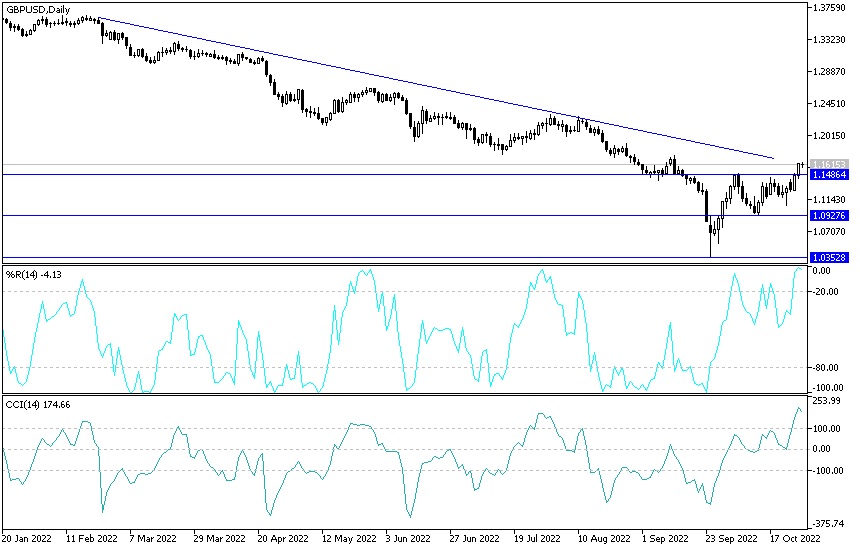- The exchange rate of the pound against the dollar, GBP/USD, rose more in the middle of this week’s trading, to reach its highest level since mid-September, with gains towards the 1.1645 resistance level.
- This happened after the rise of the Chinese renminbi and the decline in US exchange rates in general after reports of an intervention from Beijing that seemed to raise all currencies Group of Twenty.
- Prior to that, the pound gained momentum shortly after former Chancellor Rishi Sunak was declared the winner of the Conservative Party leadership election on Monday.
This came after Reuters reported that China's large state-owned banks were instructed to sell dollars in both domestic and offshore markets late on Tuesday. During Wednesday's trading session, the Chinese renminbi was the best-performing currency within the G20.
Commenting on this, Jane Foley, forex analyst at Rabobank said that “The US dollar fell for about one hour yesterday, in a move that caused the DXY to fall by about 1%. The declines in the dollar extended this morning as US Treasury yields continued to decline.”
The renminbi's outperformance is unusual as it tends to have less "beta" or lower volatility than other currencies even though the British pound is closely related to it, often tending to mimic the twists and turns of the USD/CAD. Wednesday's rally in the renminbi was followed by broad declines in the dollar, extending its trajectory back into the afternoon hours on Tuesday.
“The reason for the weakness of the US dollar is not entirely clear - it's a very strong intraday movement but something is fading given the state of global growth here," Said Jordan Rochester, an analyst at Nomura, “Overall, it has been really strange to see USDCNH rally in recent days, but the risks in stocks and DXY are sideways. The flows are chaos and narratives contradicting each other,” he added.
On Tuesday, the renminbi fell to record lows when measured by the offshore US dollar/Chinese yuan exchange rate, which has risen sharply since the beginning of April from the latest wave of Chinese restrictions related to the coronavirus. Wednesday's losses for the dollar come on the heels of potentially misplaced speculation about the upcoming Fed policy change. This happened after the Wall Street Journal reported last Friday that the Fed could raise the US interest rate by 0.75% next week and then 0.5% lower in December.
However, this is only in line with the FOMC's September forecast, which warned that US interest rates could rise to 4.5% by the end of the year and 4.75% early next year as part of the bank's response to unchanged inflation.
As for the GBP/USD, Wednesday's rally takes it back to levels last seen on September 13 and after former Prime Minister Liz Truss won the former Conservative leadership selection process. However, Wednesday's test of the 1.16 resistance leaves sterling price trading in the middle of a range which some analysts see as an attractive opportunity to sell sterling in anticipation of a downward correction expected to see the end of the year somewhere between the 1.08 and 1.12 levels.
GBP/USD Forecast
We should aim to sell from every bullish level, as the above narrative confirms that all factors are external and will not be sustainable. The pound is still facing weakness factors and the postponement of the British economy rescue plan confirms this.
The closest resistance levels for the pair are currently 1.1660, 1.1720 and 1.1800, respectively. On the other hand, according to the performance on the daily chart, the GBP/USD will return to a downward path by moving below the 1.1440 level. The currency pair will be affected today by the announcement of the US economic growth rate, durable goods orders numbers and US jobless claims.

Ready to trade our Forex technical analysis? Here are the best Forex brokers to choose from.
